As maid of honour at the late Queen’s coronation and longtime lady-in-waiting to Princess Margaret, there are few Royal secrets that Lady Glenconner, 93, doesn’t know. In the first part of our serialisation of her new book in yesterday’s Daily Mail, she gave fascinating insights into the Royals, the foibles of Britain’s aristocracy and what life has taught her over ten decades. Here, in the final part, she reveals more ‘ultimate insider’ stories…
In the end, I think the late Queen Elizabeth got on very well with the current Queen. They both love dogs and horses, and had quite a lot in common. I’ve always been a fan of Queen Camilla, I think she and the King are so well-suited and she does a marvellous job in supporting him. Camilla is the most perfect wife for him.
He probably thought it would never happen that he would be crowned King, and she would be crowned Queen. I’m so happy for them both.
My husband and I were invited to their wedding, which had to be delayed by 24 hours so that Prince Charles could attend the funeral of Pope John Paul II. That meant the wedding took place on the day of the Grand National, which wasn’t ideal for the Queen [Elizabeth] who was such a keen follower of horse-racing.
At the party afterwards, the [late] Queen gave the most wonderful speech in which she compared the course of their relationship to the racecourse at Aintree, with the couple having cleared all the obstacles in their path, crossing the finishing line and now finally enjoying being in the winners’ enclosure.
As soon as she’d finished the speech and the cake was cut, however, we noticed she beetled off to watch the race.
I’ve known King Charles since he was three. He used to come and stay at Holkham [Lady Glenconner’s ancestral home in Norfolk] with his nanny whenever he had a childhood ailment like mumps or measles. His mother had never contracted any of those illnesses, having not been sent away to school.
Living near Sandringham, I’m quite often asked to dinner if King Charles is alone. Camilla has her own children and grandchildren, and I think that at 93 she probably thinks I’m a safe pair of hands to keep him company. Over these lovely dinners, we just talk and reminisce; it’s perfect.
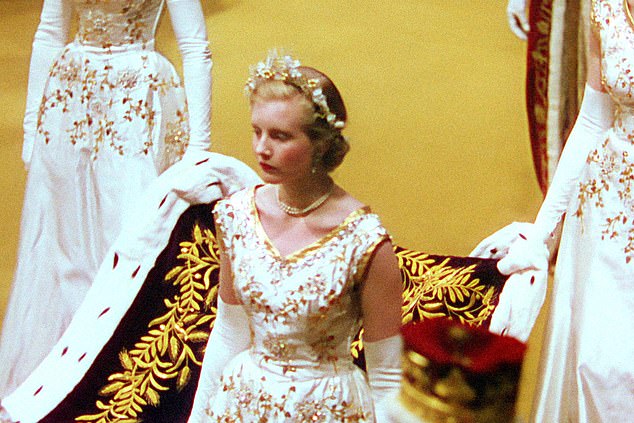
Lady Coke, now Lady Glenconner, was one of the six maids of honour at Queen Elizabeth’s coronation
A few days after his coronation, he invited me for dinner so we could talk through the ways his differed from his mother’s. There aren’t many of us who were at both, and I think he wanted to hear what I had to say.
He was just four when his mother was crowned, and he says he remembers being annoyed at having his hair plastered down with some kind of hair cream for the event.
I think he moved seamlessly into the role of King. He really cares about people, and when you see him going out among crowds and talking to them, you can see he is very much loved.
At a tea party at Buckingham Palace during the VE Day anniversary celebrations, I saw him solicitously tucking a blanket round the legs of an elderly lady sitting next to him, which is typical of his thoughtfulness.
As a boy, Charles would come over to Holkham quite often, and my father taught him to fish for eel on the lake using a long wooden trap. My father asked Charles whether he had ever eaten eel, and when he confessed he hadn’t, my father marched him to the kitchen to cook what they had caught.
The problem was that the nerves of the eel remain intact even after they were cut, so bits of eel started jumping out of the frying pan all over the kitchen floor.
I was remembering this recently with the King who told me: ‘I thought I was going to be sick.’
However, at the time, with immaculate manners as always, he had written to my mother saying politely that ‘the eel was very good, especially in butter’.
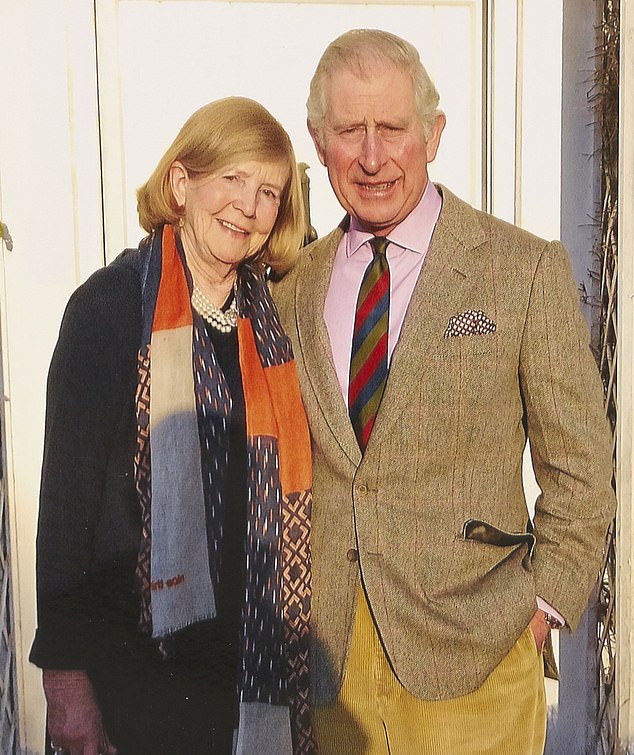
Lady Glenconner with the King. Charles visited Lady Glenconner’s family home Holkham Hall in Norfolk often as a child
Inheritance
Aristocratic families in England practise primogeniture, which in most contexts means that girls can’t inherit.
If you look when you go round some of the larger stately homes in England, you may notice that often there aren’t many pretty objects, such as little boxes, lying about on tables. Often the daughters of the house, who knew they weren’t going to be left anything, would quietly squirrel away what they could.
I knew at an early age that I wasn’t going to inherit Holkham, and my younger sister Carey and I just burst into tears when we were told at school that our mother had had a third child, who was also a little girl.
We knew how frightfully disappointing it would be to my father [the 5th Earl of Leicester], especially as my mother had such an awful time giving birth to my youngest sister Sarah that she was unable to have any more children.
It meant that the estate would have to pass to the wider family – in our case to my father’s cousin, who remained in South Africa and left the running of the estate to his son Edward, who finally inherited in 1976.
After I married Colin [Tennant, 3rd Baron Glenconner] I slightly lost count of the number of times we moved house, as Colin loved buying new properties.
But our main homes were Glen [in Scotland], the Great House in Mustique, Hill House in Notting Hill and, of course, the lovely farmhouse in Norfolk where I still live. I adored our house Glen. From the outside it looks a bit like a fairy-tale castle with lots of turrets and gargoyles in a valley surrounded by beautiful hills.
I would happily have lived there, but Colin was too impatient. It sits at the head of a valley and Colin said he couldn’t live anywhere where there was only one way out.
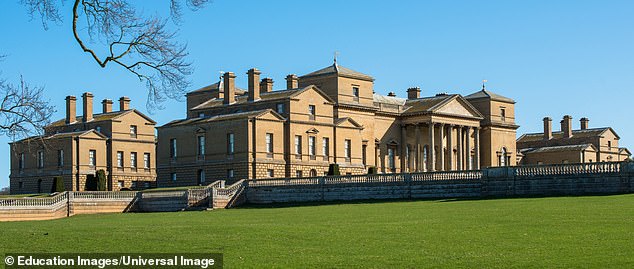
Lady Glenconner grew up in Holkham Hall, the ancestral home of her father, the 5th Earl of Leicester
At quite an early stage in our marriage, realising that Colin was extremely unreliable, my father said: ‘I think, Anne, you should have a place of your own in case you ever have to live by yourself.’
So he took me to see two farmhouses owned by the [Holkham] Estate that had become redundant as farmhouses.
One was on the marsh at Burnham Overy Staithe, and although it was lovely, it was also quite bleak. I had visions of Magwitch coming out over the marsh and was worried about flooding.
I opted instead for a house in a village close to Holkham which I totally fell in love with. It had a beautiful walled garden with lots of barns and outbuildings brimming with potential.
Colin had absolutely nothing to do with it, and so I was finally able to do up a house myself, together with a friend who worked for [fabric and wallpaper company] Colefax and Fowler.
Another friend very kindly gave me the present of the time of this marvellous decorator from Colefax and Fowler, who used to arrive in his Rolls-Royce with the back full of paints, pots and brushes, and he painted two of my main rooms.
My bedroom he painted a divine blue, which is a difficult colour to get right, but he did and it’s absolutely perfect.
I used to rent out the house over the summer, and because it’s near the sea it was always very popular. But now I’m back living here, and just being in the house and garden gives me immense pleasure.
Another very good friend of mine was the Hungarian fabric designer Michael Szell. He was thrilled to receive a summons to Buckingham Palace to discuss the redecorating of the Queen’s bedroom. He was less thrilled to be told that in fact the Queen preferred Laura Ashley to his more striking designs. All was not lost, however, and he subsequently designed the Throne Room at Windsor Castle as well as receiving a number of other commissions for the Royal Family.
Entertaining
I’ve done a great deal of entertaining in my life. Even when I was a child at Holkham my mother was often away because she was Lady of the Bedchamber to the Queen, so I used to take her place if my father had dinner parties.
We were always taught, even as children, to look people in the eye and try to think of interesting things to say.
When I married Colin he loved entertaining, and in addition to giving a lot of dinner parties in London we also had house parties when we were in Scotland at Glen in the summer.
I think the most people I ever had at the house was 36. It was a bit like running a hotel. First there was breakfast in bed – all married women had breakfast in bed. Unmarried women didn’t wear tiaras or have breakfast in bed. They had their own table by the window in the dining room, while the men sat at a separate table eating a substantial breakfast of porridge, kippers, eggs and sausage, and reading their newspapers or talking about shooting.
I used to love going to the pantry the night before to see all the breakfast trays laid out for the married women with beautiful tray cloths, a small teapot or coffee jug, egg cup, cereal bowl, napkin – the whole thing looked so pretty.
You would always be asked when you arrived what you would like to have for breakfast. This happened when I was at home as well – I always had breakfast in bed separately from Colin.
When entertaining, there were various details that were important to consider. Bedclothes always had to be linen, and the pillows would have an embroidered frill but never embroidery on the pillow itself, which would be uncomfortable to lie on. And there were generally two big square pillows on each side of a double bed, never long, always square.
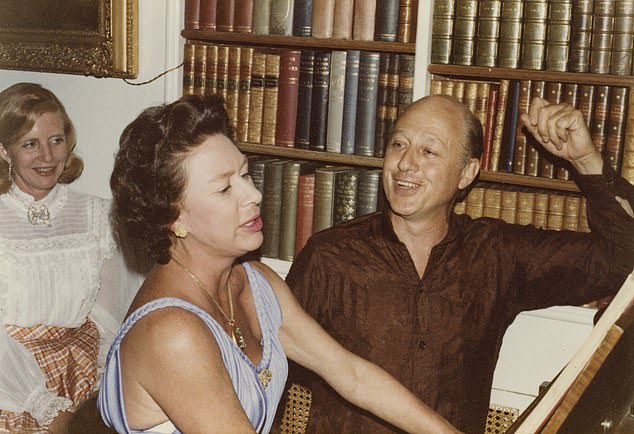
Lady Glenconner looks on while husband Colin sings and Princess Margaret plays piano
We also used to have two hot-water bottles in a double bed, one on each side, in immaculately ironed linen covers. Some men didn’t like them – Colin used to fling his on to the floor – but some of the houses we visited were freezing and they were useful.
The maids used to come in to turn down the bed and put a side light on while we were at dinner. The hot-water bottles weren’t put in until later, as we never went to bed before midnight. Woe betide finding petals or a chocolate on the bed – that would have been considered terribly common!
We used to put two types of loo paper in the bathrooms. We would fan out sheets of Bronco, the very shiny, hard paper – my father was a stickler for Bronco – and we would secure them with an attractive large crystal or a shell on top so that you could just pull out a piece at a time.
However, Bronco loo paper really didn’t do the job, so there was also nice soft paper available.
We also used to put headed writing paper on every desk in the bedrooms. Some people had little line drawings of the house on their writing paper and postcards of the house. You didn’t put out too much stationery, however, as you knew it would all be taken.
In the evening, if we were at Glen, I would oversee the laying of the dinner table to make sure it was done properly.
I would do the place à table and write out people’s names on card, so everyone knew where to sit.
The job of a hostess is to make everyone feel comfortable. You need to keep an eye open to see if anyone is being left out and, if so, bring somebody else up to them and stimulate conversation.
It’s also so important to notice if one of the guests is spending ages before dinner talking to another guest who you know they are about to sit next to at the table, as in that case you need to whisk one of them away.
There could be challenging guests. I think the most extraordinary was Raine Spencer, who became Princess Diana’s stepmother. She arrived at Glen and said she would like somebody to unpack for her, which was often done, but to my astonishment, when I was walking down the corridor, I heard a ghastly banging noise coming from her bedroom.
I went down to ask the housekeeper what was going on and she said, ‘Oh Lady Spencer said that the rail in the cupboard for her dresses wasn’t high enough and so she asked the house carpenter to come and raise it, but I thought she’d asked you?’ Of course she hadn’t, I had no idea.
Princess Margaret was by far the easiest guest, she always brought her own maid, so I really didn’t have to do anything for her.
Princess Margaret
Once I was rung up by Princess Margaret’s private secretary who said: ‘I’m going to ask you if you can do something, but you must keep it under wraps.’
He explained that the Princess was going to visit her uncle, the Duke of Windsor, and his wife who were living just outside Paris. It had to be kept secret as the Queen Mother would not have wanted Princess Margaret to go.
She hated the Windsors, partly because she knew the Duchess of Windsor mocked her, and partly because she blamed them for her husband having to become King and then becoming ill and dying prematurely.
But Margaret wanted to visit so we did a day-trip.
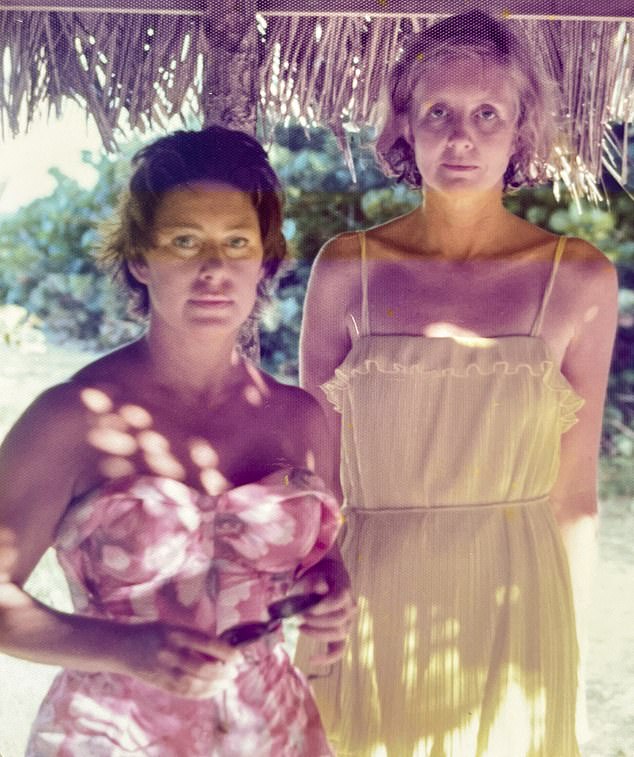
Lady Glenconner on the private island of Mustique with Princess Margaret
On the way, I asked Margaret what I should do about curtsying – the Duchess of Windsor was never given the HRH title, which meant that one didn’t have to curtsy to her. But we knew that the Duke minded very much that the Duchess had never been given the title, so I wondered whether it might just be polite to curtsy to her.
Margaret waited a moment and then said, ‘Oh, why not?’ and so I did.
I didn’t give a deep curtsy, just a little bob, but I felt it was the right thing to do – a moment when strict etiquette was at odds with the needs of tact and diplomacy.
As a lady-in-waiting, you are a go-between and must be diplomatic.
Princess Margaret used to loathe the unexpected, so I soon learnt, if we were going away to a house party for the weekend, to call in advance and find out what plans were in place and who she might be sitting next to at dinner.
I might gently suggest to the hostess that perhaps sitting Ma’am next to the bishop, when she was supposed to be off duty at the weekend, might not be the best idea.
Princess Margaret also loved the escape provided by going to the cinema. We sometimes made covert trips to the smokers’ balcony at the Coronet cinema in London’s Notting Hill to watch a matinee.
Two of her favourite films were Bonnie And Clyde, with Faye Dunaway and Warren Beatty, and, later on, Thelma And Louise. It’s interesting that they were both films about escaping from, or upending, societal expectations.
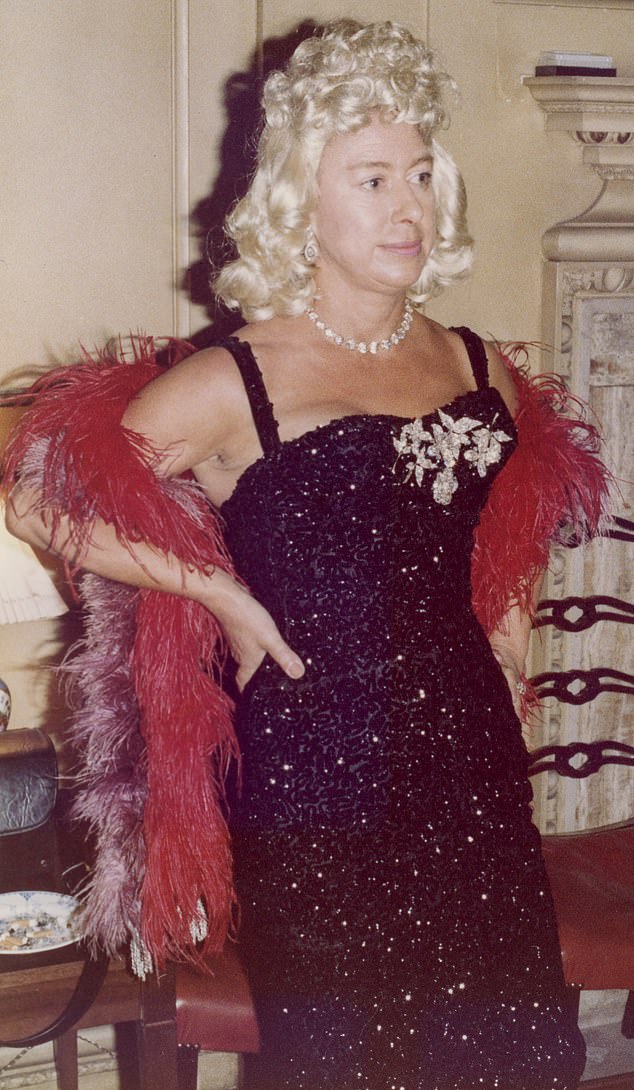
Princess Margaret at Glen dressed as American actress Mae West
Once, we were flying to America and hit the most awful thunderstorm. I was clutching on to my seat and Princess Margaret looked at me and patted my hand and said: ‘Don’t worry, Anne, we’ll either die or we’ll live and that’s that, no point worrying about it, but I think perhaps we ought to have another drink.’
I recall she liked a gin and tonic at lunchtime, whisky in the evening.
There was one time when Princess Margaret stayed with us in Scotland and sang the Chattanooga Choo Choo wearing a Victorian dress and bonnet with Roddy Llewellyn [her young boyfriend] following behind. A lot of these things she enjoyed even more because Roddy, who was also very enthusiastic, was there.
Her packing was in very grand, leather trunks which had shelves inside that lifted out like trays, to keep things separate. Everything was wrapped in acid-free tissue paper and it was all very elaborate.
One thing that Princess Margaret liked to do when staying with me in Norfolk in the spring was to go to Sandringham where the rhododendrons and azaleas were out.
Her great treat was to picnic there and sit by a huge golden Buddha statue that had been given to the future Edward VII in 1869, as a housewarming gift by Admiral of the Fleet Sir Henry Keppel [who was related to Edward VII’s mistress, Alice Keppel, Queen Camilla’s great-grandmother].
Margaret loved its patina, and we all had to stroke it the whole time, which was a little odd.
Autumn years
My children will have a marathon task scattering my ashes.
Now, aged 93, I’m having the most fun I’ve ever had in my life.
There’s so much to enjoy and look forward to.
It’s no longer the grand things that thrill me, it’s the everyday pleasures: seeing the owls in flight that are nesting in my barn, having a drink outside with friends in my garden on a summer’s day, browsing the fresh fruit and veg in my little greengrocer’s, or spending time with my family.
I’ve had a long and varied life, and not finished yet. But I do think about dying quite a bit.
Apart from anything else, there seem to be endless adverts on television saying one ought to think about various packages to budget for if one wants to be cremated or buried, so it’s hard to avoid.
I’ve been slightly putting it off, but I am going to get down to it and tell the children exactly what I want for my funeral service, which will be at my local church in Burnham Thorpe.
It’s Horatio Nelson’s church and I’ve worshipped here for nearly 50 years. I want to be cremated and I’m going to give very precise instructions about where my ashes are to be scattered.
I want them to be divided, and for some of me to buried with my parents in the churchyard at Holkham and the rest to be scattered where my darling son Henry [who died from Aids, aged 29, in 1990] was scattered on the Green Hill at Glen.
Look out children – it’s going to be a bit of a marathon exercise!
© Anne Glenconner, 2025 Adapted from Manners And Mischief by Lady Glenconner, to be published by Bedford Square on November 6 at £18.99. To order a copy for £17.09 (offer valid to November 8; UK p&p free for orders over £25) go to mailshop.co.uk/books or call 020 3176 2937.
